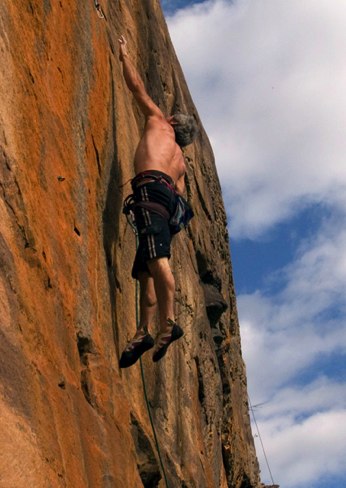הבדלים בין גרסאות בדף "Dynamic move"
(דף חדש: {{LTR}} left|thumb|300px|an all-out dyno '''צעד דינאמי''' A '''dynamic move''' or '''dyno''') is a climbing move that's irreversible, that is, tha…) |
|||
| (גרסת ביניים אחת של אותו משתמש אינה מוצגת) | |||
| שורה 3: | שורה 3: | ||
'''[[צעד דינאמי]]''' | '''[[צעד דינאמי]]''' | ||
| − | A '''[[dynamic move]]''' or '''dyno''' | + | A '''[[dynamic move]]''' or '''dyno''' is a climbing move that's irreversible, that is, that the climber cannot stop in mid-move and revert to the previous posture. As a matter of fact, every climbing movement that has swing or momentum is a dyno. |
| − | Moving dynamically is more power efficient and enables the climbers to save energy and when he is short of it, perform hard moves he cannot do statically. Dynamic moves are common in hard [[ | + | Moving dynamically is more power efficient and enables the climbers to save energy and when he is short of it, perform hard moves he cannot do statically. Dynamic moves are common in hard [[boldering]] but are used occasionally on real [[climbing routes]], even while [[leading]]. |
Dynamic moves require a mixture of [[explosive power]], [[fitness#speed|speed]] and a lot of [[fitness#coordination|coordination]]. Precision is very important, as is timing. | Dynamic moves require a mixture of [[explosive power]], [[fitness#speed|speed]] and a lot of [[fitness#coordination|coordination]]. Precision is very important, as is timing. | ||
גרסה אחרונה מ־03:56, 25 בנובמבר 2009
A dynamic move or dyno is a climbing move that's irreversible, that is, that the climber cannot stop in mid-move and revert to the previous posture. As a matter of fact, every climbing movement that has swing or momentum is a dyno.
Moving dynamically is more power efficient and enables the climbers to save energy and when he is short of it, perform hard moves he cannot do statically. Dynamic moves are common in hard boldering but are used occasionally on real climbing routes, even while leading.
Dynamic moves require a mixture of explosive power, speed and a lot of coordination. Precision is very important, as is timing.
A dyno normally starts with a strong pull or push. The idea is to move the hand (or foot) to the next hold at the exact instant when there is no weight on it at all. This happens at the apex of height of the movement, when the center of mass stopped going up, and just before it starts to come down.
In practice, we distinguish between a few levels of dynamic moves:
- Semi-dynamic moves, that have a momentum, but you can still revert to the last hold. Jumping your hand or foot to the next hold fall into that category.
- Dynamic moves usually move a hand or foot, but at least one hand or foot remain on a hold.
- All out dynos include a big jump, where all four limbs leave the wall.
- Double dynos include a jump and a use of an intermediate hold to pull further, change direction or improve precision, in order to complete the move and get to the final hold.
Contributions to this page were made by Mica Yaniv and others...
